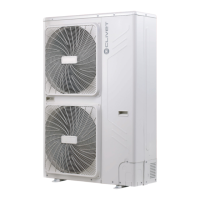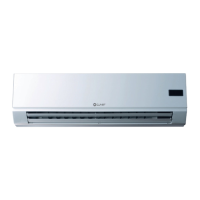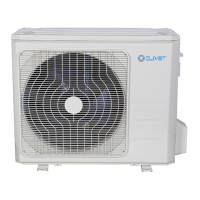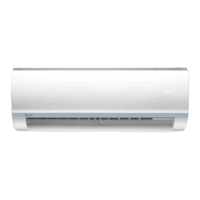31
Electrical connections
5
ELECTRICAL CONNECTIONS
5.1 Preliminary information
f
ATTENTION ELECTRIC DANGER
– All electrical connections must be done
by a licensed electrician according to the
provisions of national and local electrical
codes.
– All electrical connections must be made
according to the wiring diagram on the
panels of the indoor and outdoor units.
– If the electrical system has serious safety
problems, stop work immediately. Explain
the situation to the customer and refuse to
install the unit until the safety problem has
been resolved.
– The power supply must be between 342
V and 456 V.
Insucient power supply can
cause malfunction, electric shock or fire.
– Install overcurrent protection and a main
power switch (see “5.2 Power supply line”
page 32).
– The power supply line must have a special
protection upstream against short circuits
and earthing leakage that sections the
system with respect to other utilities. The
technician must choose an approved
dierential circuit-breaker or main circuit
breaker.
– The air conditioner must be properly
grounded.
– All cables and conductors must be
connected securely. Loosening a conductor
may cause the terminal to overheat, which
in turn may result in fire hazards or product
malfunction.
– The electrical cables must not touch or rest
against the refrigerant pipes, the compressor
or any moving parts of the unit.
– The voltage dierence between N and T
must not exceed 3 V. Higher values indicate
suboptimal earthing and can cause failure of
the electronics.
f
ATTENTION ELECTRIC DANGER
Before making electrical connections, turn o
the main switch of the system.
m
CAUTION
In order to remove the entire electrical panel:
– empty the refrigeration circuit, taking care to
recover the refrigerant;
– desolder the pipe connected to the heat
sink which cools the electrical panel
– disconnect the electrical cables.
l
WARNING
The electrical system can be divided into two
sub-families: the power supply line and the
communication bus network. Be careful during
the installation process.
l
WARNING
The insulation of the metal parts and air
conditioner must comply with the provisions of
the national electrical code.
l
WARNING
Installation and wiring must be carried out
by duly qualified, certified and accredited
professionals, in compliance with current
regulations.
a
CAUTION
The refrigerant piping, power cables and
communication cables are usually laid in
parallel. The power and communication
cables must be laid in separate conduits to
avoid signal interference. If the power supply
is less than 10A, the two conduits must be at
least 300 mm apart. In case of a higher power
supply rating (between 10 and 50A), the two
conduits must be at least 500 mm apart.
f
ATTENTION ELECTRIC DANGER
– Make sure that the unit is earthed. Keep the
earth wire away from gas and water pipes,
lightning rods, telephone cables or other
earth wires. Incorrect earthing may cause
electric shocks.
– Automatic overcurrent and dierential
switches (earthing switches) must be used in
accordance with all the regulations in force
a
CAUTION
The outdoor units are based on DC inverter
technology. Pay attention to the type of power
supply: the use of a UPS can damage the unit’s
power electronics.

